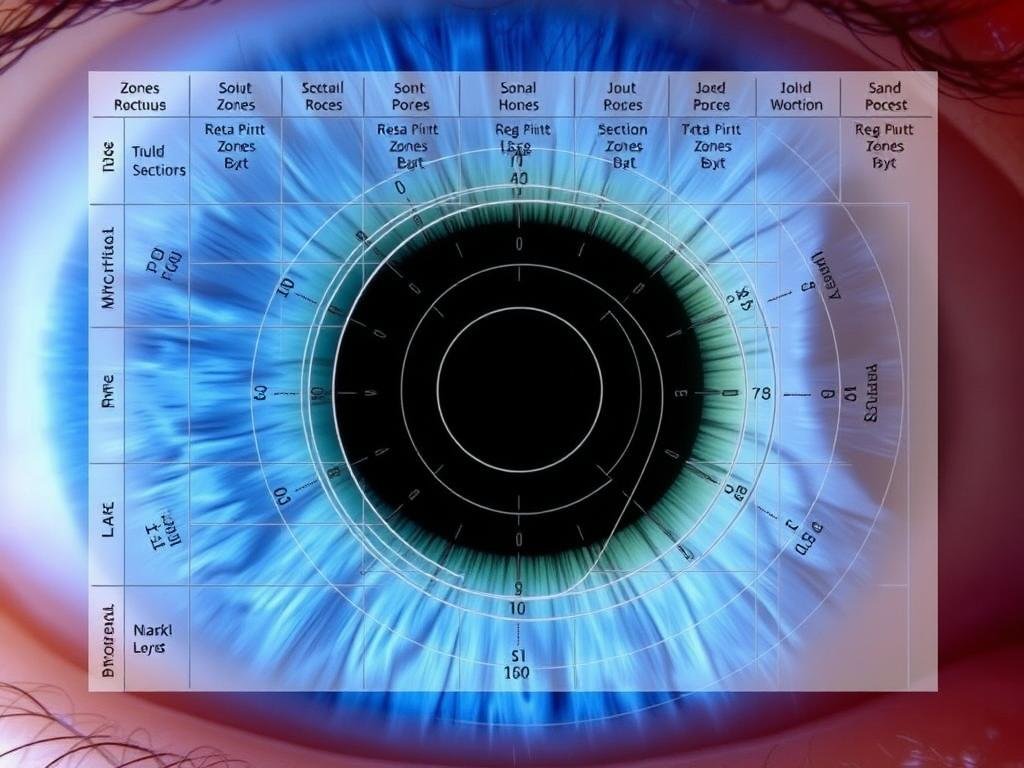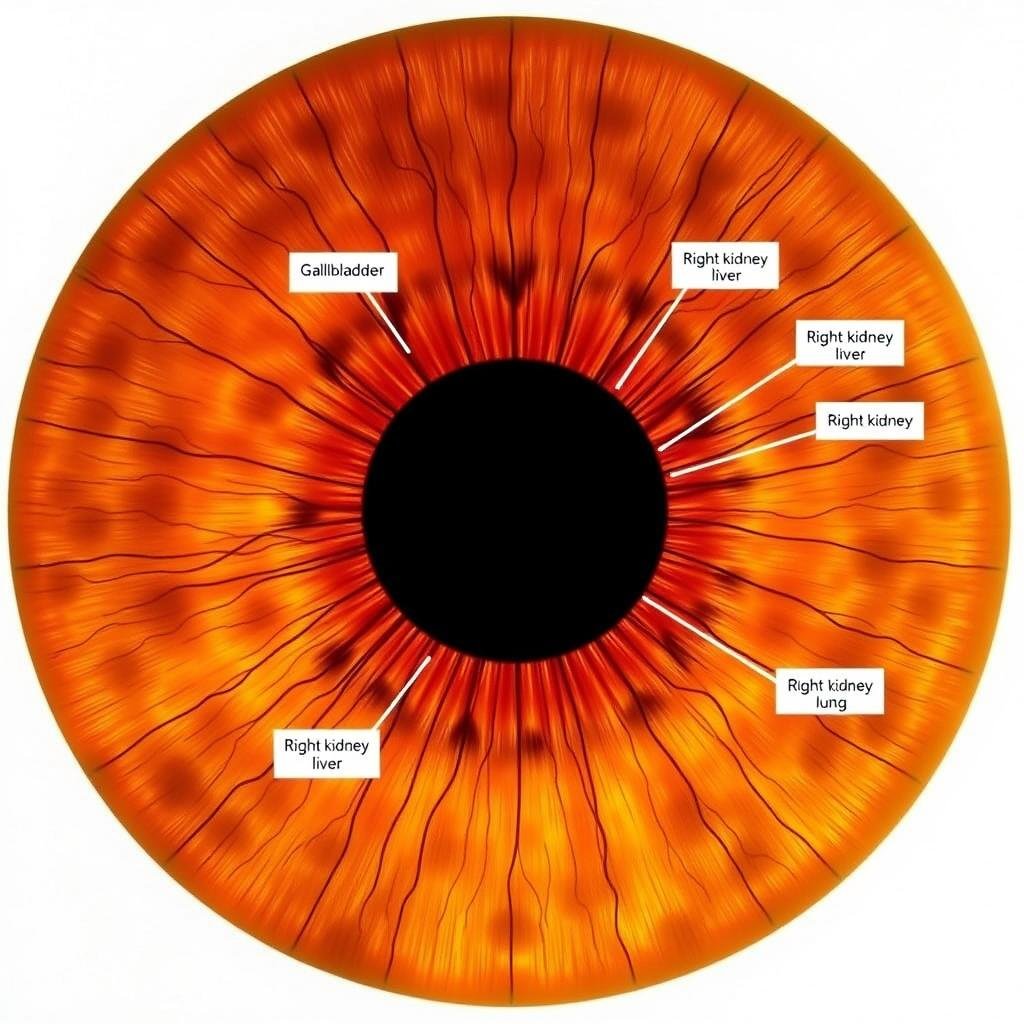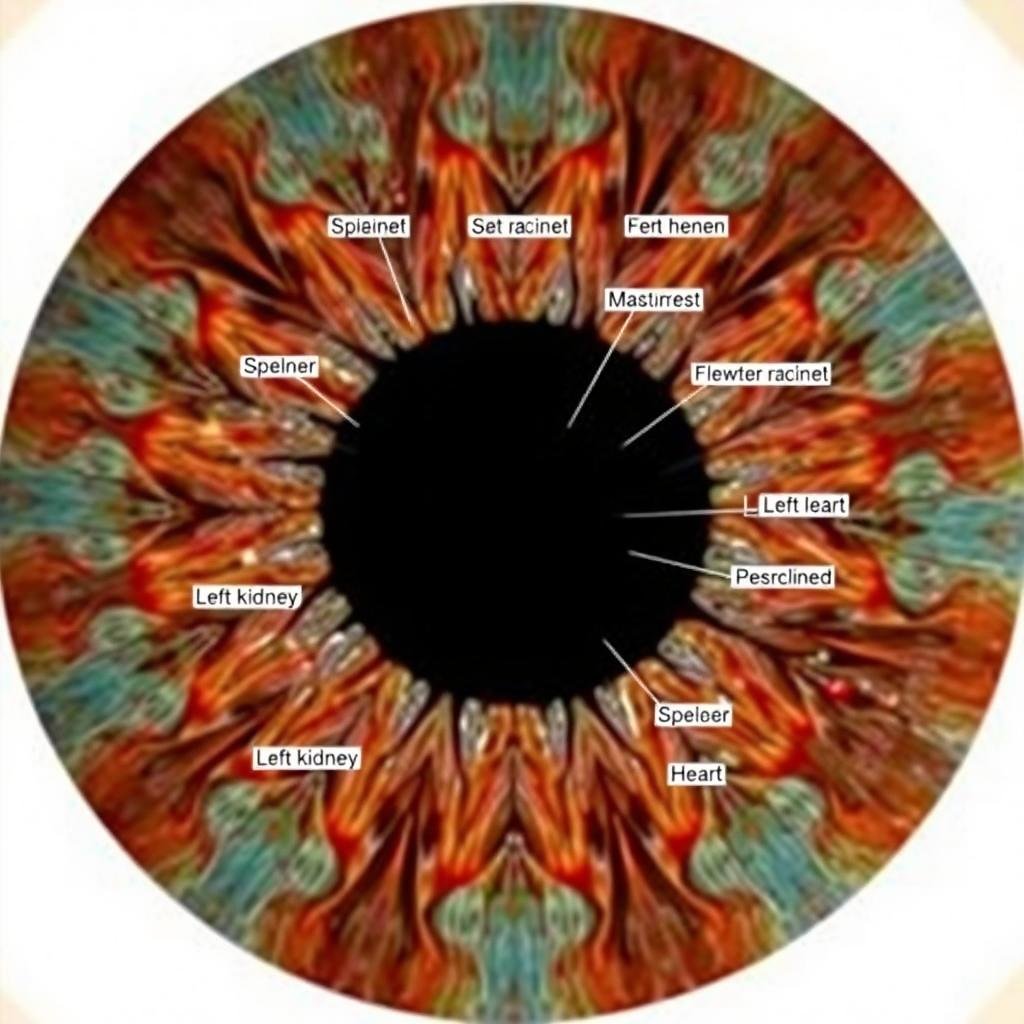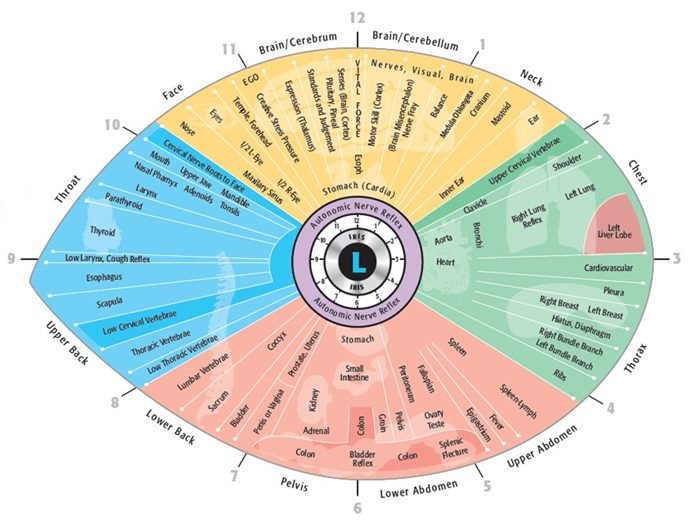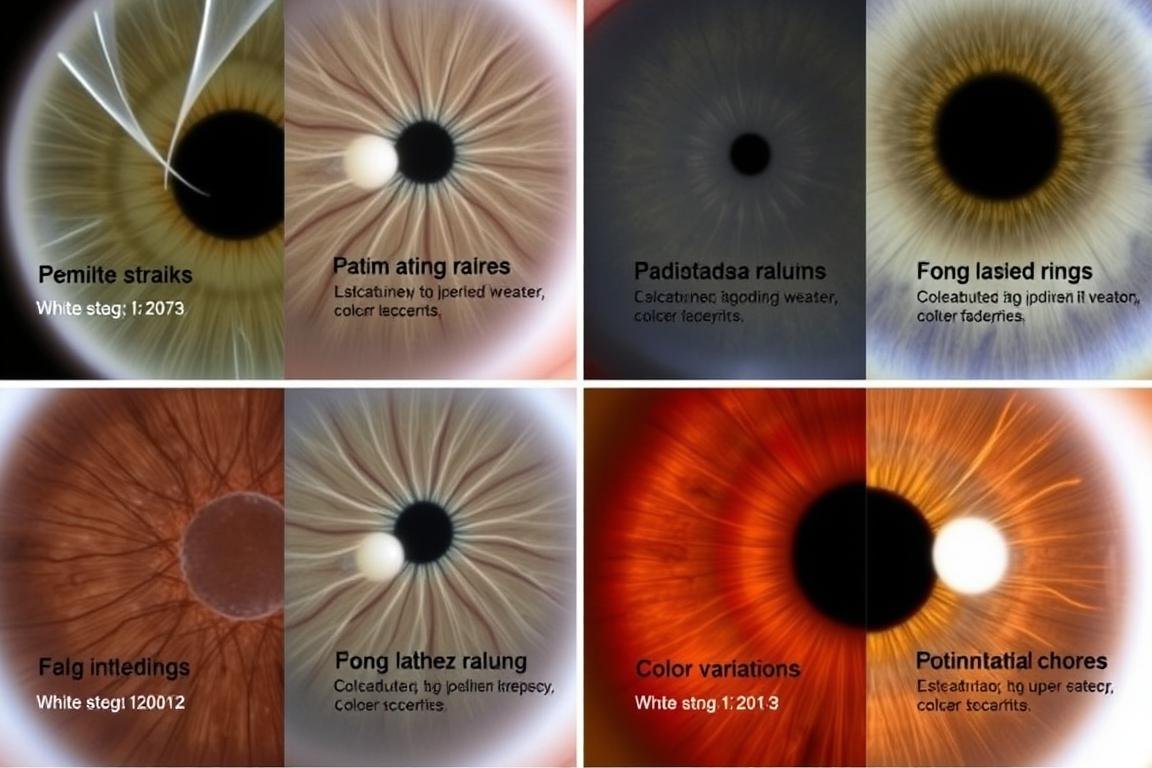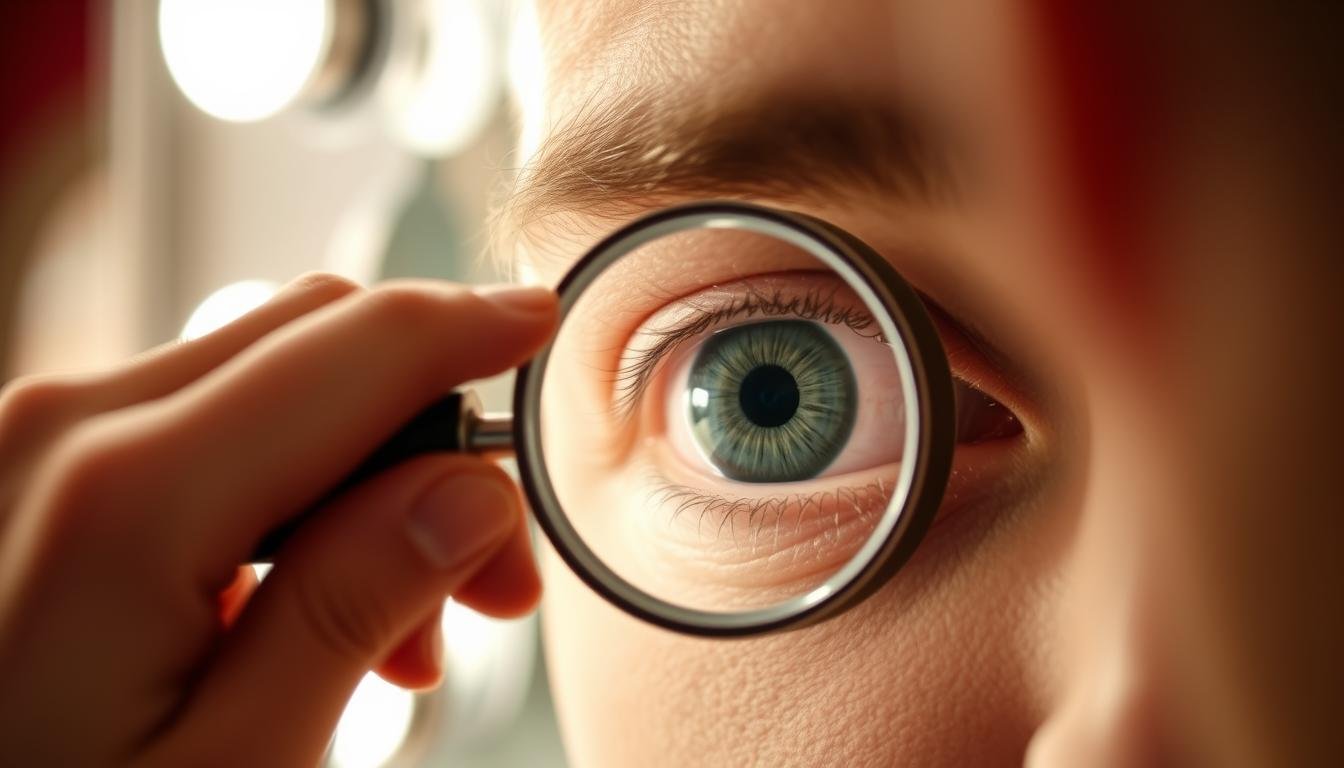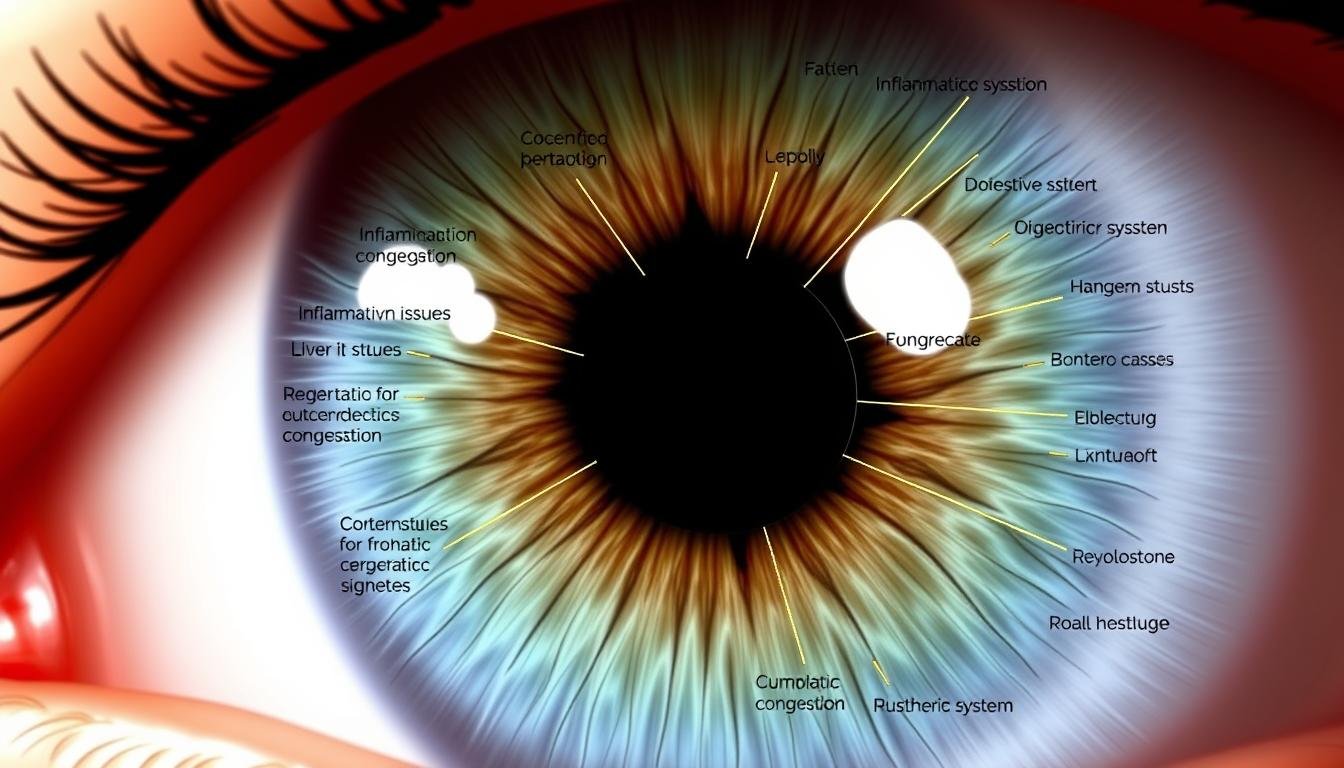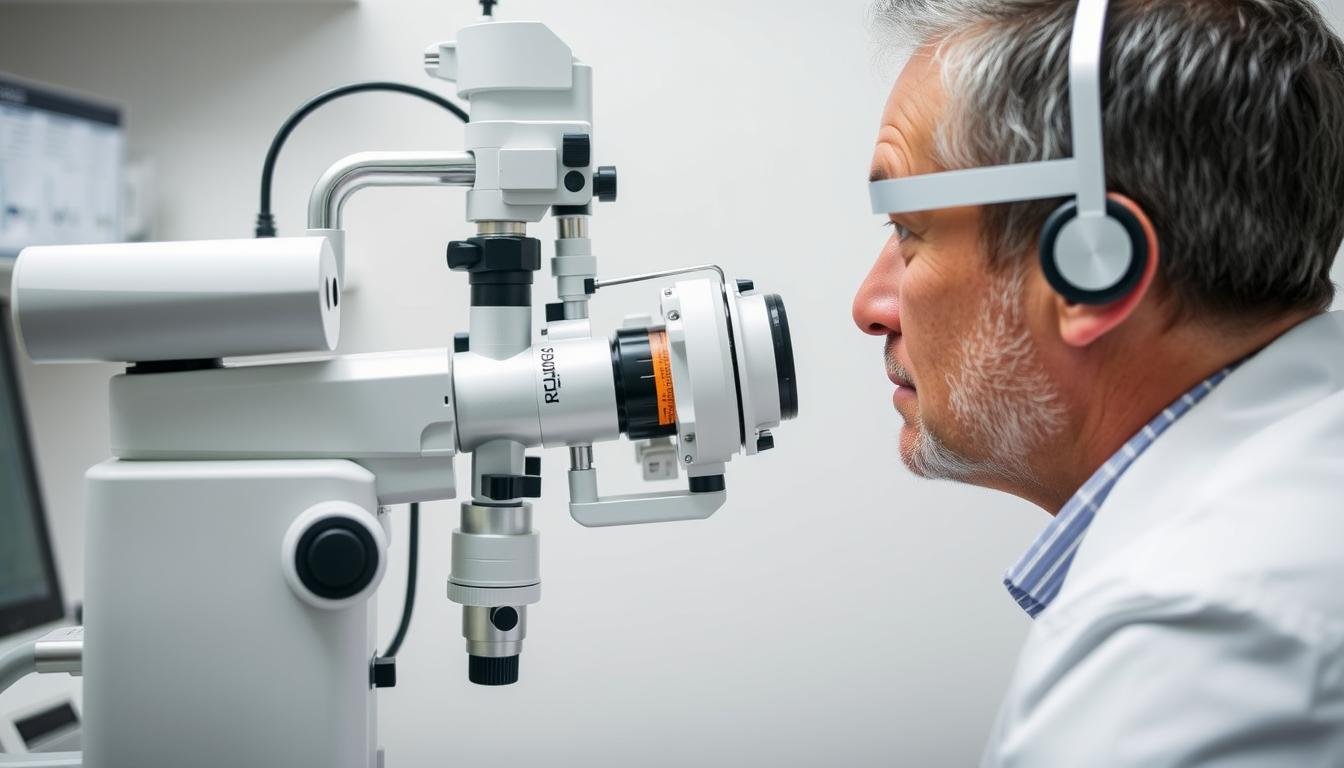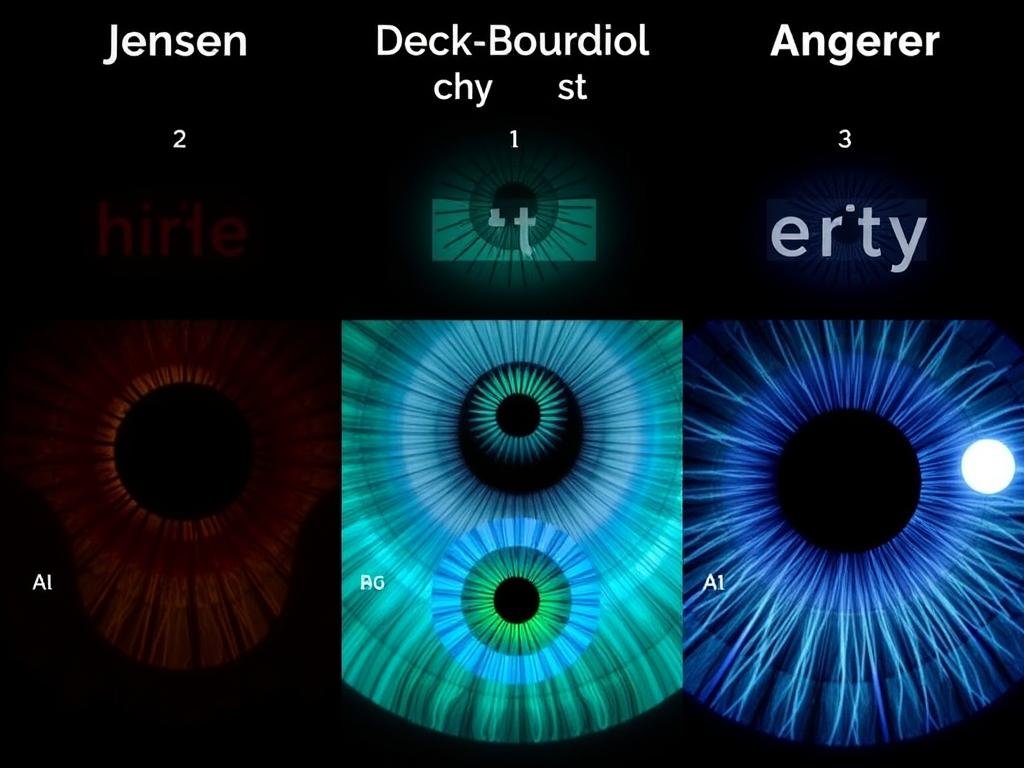The human iris contains intricate patterns as unique as fingerprints. Iridology charts map these patterns to different body systems, creating a fascinating window into potential health conditions. This comprehensive guide explores how practitioners use iridology chart, their historical origins, and the ongoing debate about their effectiveness in alternative medicine.
Čo je to iridologická mapa?
A iridológia serves as a detailed map that divides the iris into zones, each corresponding to different organs and systems within the body. Practitioners use these charts to analyze the color, texture, and markings in your iris to identify potential health imbalances before they manifest as physical symptoms.
A standard iridology chart mapping iris zones to corresponding body systems
These specialized charts provide a framework for iridologists to interpret what they observe in your eyes. While conventional medicine remains skeptical, proponents believe these charts offer insights into your body’s strengths, weaknesses, and potential health concerns.
The Historical Origins of Iridology Charts
The practice of examining the iris for health insights dates back thousands of years, with roots in ancient Egypt, China, and India. However, modern iridology charts emerged in the 19th century through the work of Hungarian physician Ignatz von Peczely.

Ignatz von Peczely, considered the father of modern iridology
As a child, von Peczely noticed changes in an owl’s iris after the bird suffered a broken leg. This observation sparked his lifelong study of the connection between iris markings and physical health. In 1880, he published the first comprehensive iridology chart, mapping specific iris zones to organs and body systems.
Throughout the 20th century, practitioners like Bernard Jensen further refined these charts, creating the detailed mapping systems used by modern iridologists today. These evolving charts reflect decades of observation and documentation by alternative health practitioners.
Key Components of an Iridology Chart
Understanding how to read an iridológia requires familiarity with its fundamental components. Each chart typically divides the iris into concentric zones and radial sections, creating a comprehensive map of the body.


Iridology chart overlay on a human iris showing mapping zones
Primary Sections of an Iridology Chart
- Zóna župy – The area immediately surrounding the pupil, associated with the digestive system and stomach
- Collarette/Autonomic Nerve Wreath – The jagged boundary separating the pupillary zone from the ciliary zone, representing the autonomic nervous system
- Ciliárna zóna – The middle area of the iris, containing markings related to most organs and tissues
- Iris Edge/Periphery – The outer rim of the iris, associated with the skin, lymphatic system, and circulation
- Radial Zones – Pie-shaped sections extending from the pupil to the edge, each linked to specific organs
- Medzera – Closed, often darkened areas indicating potential inherent weaknesses
- Krypty – Open, usually lighter areas suggesting acute conditions
Each iris is further divided into approximately 60 sectors corresponding to different body parts. The right iris generally reflects the right side of the body, while the left iris corresponds to the left side.
Right and Left Iris Interpretation
Iridology charts typically show different mappings for the right and left iris, as each is believed to correspond to different sides and systems of the body.


Right iris chart mapping
Right Iris Correlations
- Brain and right side of head
- Right lung and bronchi
- Liver and gallbladder
- Pravá oblička
- Ascending and transverse colon
- Správne reprodukčné orgány

Left iris chart mapping
Left Iris Correlations
- Left side of brain and head
- Heart and left lung
- Stomach and spleen
- Ľavá oblička
- Descending colon
- Left reproductive organs
Practitioners analyze both irises together to form a complete picture of the body’s health status. Asymmetries between the eyes may indicate imbalances requiring attention.
To make diagnosis more accurate, iridológia is often use in conjunction with other diagnostic methods.

Iridologický graf pravé oko -Iridology Graf -pravé oko
pravé oko odrážať pravá strana telo.
| Poloha hodín (pravé oko) | Zodpovedá orgánu/systému | Podrobnosti |
|---|
| 1 hodiny - 2 hodiny | Pravá tvár | Zodpovedá ľavým reprodukčným orgánom, zahŕňa maternicu, vaječníky (ženy) alebo semenníky (muž). |
| 2 hodiny - 3 hodiny | Pravý krk
| Ringflects Health ľavé kĺby, zahŕňajú kolená, boky, lakte a ramená. |
| 3 hodiny - 4 hodiny | Pravý horný chrbát
| Zodpovedá chrbtici, zdraviu chrbtice, zarovnania a flexibility. |
| 4 hodiny - 5 hodín | Pravý močový mechúr | Ringflects močový mechúr a močový systém na pravej strane. |
| 5 hodín - 6 hodín | Pravá panvová | Ringsents vľavo hrubé črevo, tenké črevo a zdravie trávenia. |
| 6 hodín - 7 hodín | Pravé dolné brucho
| Ringflecty vľavo obličky, zamerané na filtráciu, detoxikáciu a rovnováhu tekutín. |
| 7 hodín - 8 hodín | Pravé horné brucho
| Ringflekty žalúdka a tráviace orgány na ľavej strane. |
| 8 hodín - 9 hodín | Pravý hrudník | Zodpovedá ľavej bočnej pečeni, zodpovednej detoxikácii a výrobe žlče. |
| 9 hodín - 10 hodín | Pravá pľúca | Ringsents na ľavej strane srdca, ovplyvňujú kardiovaskulárne zdravie a obeh. |
| 10 hodín - 11 hodín | Pravý krk | Ringflekty ľavého pľúc, zdravie dýchacích ciest a funkcia breasu. |
| 11 hodín - 12 hodín | Pravý mozog
| Zodpovedá mozgu ľavej hemisféry, duševného zdravia a kognitívnych funkcií. |
| 12 hodín - 1 hodiny | Pravý mozog
| Zodpovedá mozgu ľavej hemisféry, duševného zdravia a kognitívnych funkcií. |

Iridology Chart Left Eye – Iridology Chart – Left Eye
ľavé oko odrážať ľavá strana telo.
| Clock Position (Left Eye) | Zodpovedá orgánu/systému | Podrobnosti |
|---|
| 1 hodiny - 2 hodiny | Left NECK
| Corresponds to right reproductive organs, include uterus, ovaries (female) or testes (male). |
| 2 hodiny - 3 hodiny | Left LUNG | Ringflects health right joints, include knees, hips, elbows, and shoulders. |
| 3 hodiny - 4 hodiny | Left THORAX | Corresponds to spine, spinal health, alignment, and flexibility on right side. |
| 4 hodiny - 5 hodín | Left UPPER ABDOMEN
| Ringflects bladder and left side urinary system. |
| 5 hodín - 6 hodín | Left LOWER ABDOMEN
| Ringpresents right colon, small intestine, and digestive health. |
| 6 hodín - 7 hodín | Left PELVIC
| Ringflects right kidney, focuse on filtration, detoxification, and fluid balance. |
| 7 hodín - 8 hodín | Left LOWER BACK
| Ringflects stomach and digestive organs on right side. |
| 8 hodín - 9 hodín | Left UPPER BACK
| Corresponds to right side liver, responsible detoxification and bile production. |
| 9 hodín - 10 hodín | Left THROAT
| Ringpresents right side heart, affecte cardiovascular health and circulation. |
| 10 hodín - 11 hodín | Left FACE | Ringflects right lung, respiratory health, and brea function. |
| 11 hodín - 12 hodín | Left CEREBRUM | Corresponds to right hemisphere brain, mental health, and cognitive functions. |
| 12 hodín - 1 hodiny | Left CEREBRUM | Corresponds to right hemisphere brain, mental health, and cognitive functions. |
- Right Eye: Ringflects Right side body (e.g., Right kidney, Right lung, Right reproductive organs, etc.).
- Left Eye: Ringflects Left side body (e.g., Left kidney, Left lung, Left reproductive organs, etc.).
Interpreting Iris Colors and Markings
Beyond the zonal mapping, iridology charts include guidelines for interpreting various colors, textures, and markings found in the iris. These features provide additional layers of information about potential health conditions.

Spoločné označenia dúhovky a ich interpretácie v iridológii
Common Iris Signs and Their Meanings
| Dúhovka | Vzhľad | Potenciálna indikácia |
| White Rings | Circular white lines around the iris | Possible high cholesterol or arterial tension |
| Temné škvrny | Brown or black flecks | Potential toxin accumulation or organ damage |
| Radial Lines | Lines extending from pupil to iris edge | Nerve stress or circulation issues |
| Yellow Tint | Žltkastoografie | Possible kidney or liver stress |
| Medzera | Closed, dark, often oval areas | Inherent weakness in corresponding organ |
| Lymfatický ruženec | White dots forming a circle | Preťaženie lymfatického systému |
Iris color also plays a significant role in iridology analysis. Blue irises (lymphatic constitution) may indicate different tendencies than brown irises (hematogenic constitution) or mixed irises (biliary constitution).
How to Use an Iridology Chart at Home
While professional iridology requires training and experience, you can perform basic iris observation at home. This preliminary self-assessment might spark insights worth discussing with a qualified practitioner.

Basic self-examination using proper lighting and magnification
Steps for Basic Iris Self-Examination
- Gather equipment: A small flashlight, magnifying glass, and mirror in a well-lit area
- Position lighting: Place the light source at a 45-degree angle to your eye to avoid reflections
- Examine each iris: Look for color variations, markings, rings, and spots
- Compare with a chart: Reference a basic iridology chart to understand what you’re seeing
- Document observations: Take notes or photos to track changes over time
- Consult a professional: Share your observations with a trained iridologist for proper interpretation
Want to Learn More About Iris Analysis?
Download our comprehensive iridology chart reference guide to start your journey into understanding what your eyes might reveal about your health.
Download Free Iridology Chart Guide
Remember that self-assessment is merely educational and should not replace professional medical advice or diagnosis from qualified healthcare providers.
Health Conditions Iridology Claims to Detect
Practitioners of iridology believe that various markings and patterns in the iris can indicate potential health issues in corresponding body systems. While scientific evidence remains limited, these are some conditions that iridologists commonly claim to identify through iris analysis.

Iridology mapping of common health conditions to iris regions
Tráviaci systém
- Intestinal inflammation
- Stomach acidity issues
- Malabsorption concerns
Circulatory System
- Blood pressure tendencies
- Circulation efficiency
- Cholesterol indications
Elimination Systems
- Kidney and bladder stress
- Liver congestion
- Lymphatic system stagnation
Iridologists emphasize that these indications represent tendencies or predispositions rather than definitive diagnoses. The iris may show constitutional weaknesses that could develop into health issues if not addressed through lifestyle modifications.
Curious About What Your Iris Reveals?
Connect with a certified iridology practitioner for a personalized analysis of your iris patterns and what they might indicate about your health tendencies.
Find an Iridologist Near You
The Scientific Perspective on Iridology
While iridology has passionate advocates, it’s important to understand the scientific community’s perspective. Conventional medicine has conducted several controlled studies examining iridology’s diagnostic claims with mixed results.
Zástancovia tvrdia
- The iris contains over 28,000 nerve fibers connected to the brain
- Anecdotal success stories support its effectiveness
- It offers a non-invasive approach to health assessment
- It may detect imbalances before symptoms appear
Kritici poukazujú na to
- Limited peer-reviewed research supports its claims
- Controlled studies show inconsistent diagnostic accuracy
- Iris patterns are largely determined by genetics
- Potential delay in seeking conventional medical treatment

Modern ophthalmological examination differs from iridology analysis
Most medical organizations, including the American Academy of Ophthalmology, do not recognize iridology as a valid diagnostic method. However, some integrative health practitioners incorporate it as one component of a holistic health assessment rather than a standalone diagnostic tool.
Často kladené otázky týkajúce sa iridologických grafov
How accurate are iridology charts in diagnosing health conditions?
The accuracy of iridology remains controversial. While practitioners report success in identifying health tendencies, scientific studies have produced inconsistent results. Most medical professionals consider iridology charts insufficient for medical diagnosis. They may provide insights into constitutional tendencies but should not replace conventional medical testing.
Can iridology charts detect serious conditions like cancer?
Responsible iridologists do not claim to diagnose specific diseases like cancer through iris analysis. Instead, they may identify areas of stress or weakness in body systems. Any concerning findings should prompt consultation with medical professionals for proper diagnostic testing.
Do iris patterns change over time?
While the basic structure and color of the iris remain relatively stable throughout life, iridologists believe that certain markings can change to reflect health status. These changes typically occur gradually and may reflect long-term health conditions rather than acute issues.
Are all iridology charts the same?

Comparison of three major iridology chart systems showing variations in mapping
Conclusion: The Place of Iridology Charts in Health Assessment
Iridology charts represent a fascinating intersection of ancient observation and alternative health practices. While they continue to generate debate in medical circles, many people find value in the holistic perspective they offer.
Whether you approach iridology with enthusiasm or skepticism, understanding these intricate iris maps provides insight into a unique health assessment method with a long historical tradition. As with any health approach, balance is key—consider iridology as one potential tool in a comprehensive health strategy rather than a standalone diagnostic system.
For those intrigued by what their eyes might reveal, consulting with both conventional medical professionals and qualified iridology practitioners offers the most balanced approach to health assessment and maintenance.
Preskúmajte iridológiu ďalej
Ready to discover what your iris patterns might reveal about your health? Download our comprehensive guide and connect with certified practitioners.
Get Your Free Iridology Resource Kit




